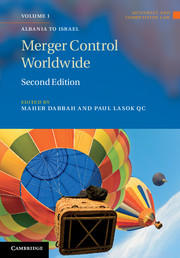Book contents
- Frontmatter
- Contents
- Preface
- List of Contributors
- Table of cases
- Table of Legislation and Official Guidance
- Introduction
- Albania
- Argentina
- Armenia (Republic of Armenia)
- Australia
- Austria
- Barbados
- Belgium
- Bosnia and Herzegovina
- Brazil
- Bulgaria (Republic of Bulgaria)
- Canada
- Chile
- China*
- Costa Rica
- Croatia
- Cyprus (Republic of Cyprus)
- Czech Republic
- Denmark
- Estonia
- European Economic Area
- European Union
- Finland
- France
- Germany (Federal Republic of Germany)
- Greece
- Hong Kong
- Hungary
- Iceland
- India
- Indonesia (Republic of Indonesia)
- Ireland
- Israel
- Italy
- Japan
- Kenya
- Korea
- Latvia
- Lithuania
- Macedonia (Republic of Macedonia)
- Malta
- Mexico
- Netherlands (The Netherlands)
- New Zealand
- Norway
- Pakistan
- Peru
- Philippines (Republic of the Philippines)
- Poland
- Portugal
- Romania
- Russia
- Serbia
- Singapore
- Slovakia (Slovak Republic)
- Slovenia
- South Africa
- Spain
- Sri Lanka
- Sweden
- Switzerland
- Taiwan
- Thailand
- Tunisia (Republic of Tunisia)
- Turkey
- Ukraine
- United Kingdom
- United States of America
- Uzbekistan
- Venezuela
- Zambia
- Index
European Economic Area
Published online by Cambridge University Press: 05 November 2014
- Frontmatter
- Contents
- Preface
- List of Contributors
- Table of cases
- Table of Legislation and Official Guidance
- Introduction
- Albania
- Argentina
- Armenia (Republic of Armenia)
- Australia
- Austria
- Barbados
- Belgium
- Bosnia and Herzegovina
- Brazil
- Bulgaria (Republic of Bulgaria)
- Canada
- Chile
- China*
- Costa Rica
- Croatia
- Cyprus (Republic of Cyprus)
- Czech Republic
- Denmark
- Estonia
- European Economic Area
- European Union
- Finland
- France
- Germany (Federal Republic of Germany)
- Greece
- Hong Kong
- Hungary
- Iceland
- India
- Indonesia (Republic of Indonesia)
- Ireland
- Israel
- Italy
- Japan
- Kenya
- Korea
- Latvia
- Lithuania
- Macedonia (Republic of Macedonia)
- Malta
- Mexico
- Netherlands (The Netherlands)
- New Zealand
- Norway
- Pakistan
- Peru
- Philippines (Republic of the Philippines)
- Poland
- Portugal
- Romania
- Russia
- Serbia
- Singapore
- Slovakia (Slovak Republic)
- Slovenia
- South Africa
- Spain
- Sri Lanka
- Sweden
- Switzerland
- Taiwan
- Thailand
- Tunisia (Republic of Tunisia)
- Turkey
- Ukraine
- United Kingdom
- United States of America
- Uzbekistan
- Venezuela
- Zambia
- Index
Summary
The European Economic Area (EEA) was created by the Agreement on the European Economic Area, signed at Oporto, Portugal, on 2 May 1992 (‘the EEA Agreement’), which entered into force on 1 January 1994. The EEA was originally intended to create an economic association between two economic blocs in Europe: the European Economic Community (now more often known as the European Union or EU) and the European Free Trade Association (EFTA). In the event, one of the members of EFTA, the Swiss Confederation, declined to ratify the EEA Agreement. Accordingly, the EEA Agreement came into effect as between the EU, and its Member States, and the remaining member states of EFTA (the Republic of Iceland, the Principality of Liechtenstein and the Kingdom of Norway). The EEA therefore comprises all the current Member States of the EU (numbering, at the time of writing, 27) plus Iceland, Liechtenstein and Norway. EFTA remains in existence. Those member states of EFTA that are also members of the EEA are often referred to as ‘the EEA EFTA States’ but, in the EEA Agreement itself, and in similar texts, the phrase ‘EFTA States’ is used. In order to avoid confusion, the phrase ‘EEA EFTA States’ will be used in this chapter to describe those EFTA States that are signatories to the EEA agreement.
Relevant legislation and statutory standards
Article 57 of the EEA Agreement provides that concentrations which create or strengthen a dominant position, as a result of which effective competition would be significantly impeded within the territory covered by the EEA Agreement or a substantial part of it, are incompatible with the Agreement. For the purposes of applying Article 57, use is made of the criteria and concepts to be found in EC Regulation No. 139/2004. That Regulation and the provisions that implement Article 57 of the EEA Agreement also contemplate that, in certain circumstances, a concentration may be referred to a Member State of the EU or an EEA EFTA State to be dealt with under the legislation of that State.
- Type
- Chapter
- Information
- Merger Control Worldwide , pp. 433 - 442Publisher: Cambridge University PressPrint publication year: 2012



